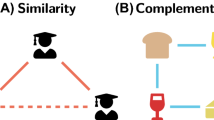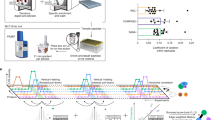Abstract
We introduce clustering with overlapping neighborhood expansion (ClusterONE), a method for detecting potentially overlapping protein complexes from protein-protein interaction data. ClusterONE-derived complexes for several yeast data sets showed better correspondence with reference complexes in the Munich Information Center for Protein Sequence (MIPS) catalog and complexes derived from the Saccharomyces Genome Database (SGD) than the results of seven popular methods. The results also showed a high extent of functional homogeneity.
This is a preview of subscription content, access via your institution
Access options
Subscribe to this journal
Receive 12 print issues and online access
$259.00 per year
only $21.58 per issue
Buy this article
- Purchase on Springer Link
- Instant access to full article PDF
Prices may be subject to local taxes which are calculated during checkout

Similar content being viewed by others
References
Enright, A.J., van Dongen, S. & Ouzounis, C.A. Nucleic Acids Res. 30, 1575–1584 (2002).
King, A., Pržulj, N. & Jurisica, I. Bioinformatics 20, 3013–3020 (2004).
Pu, S., Wong, J., Turner, B., Cho, E. & Wodak, S. Nucleic Acids Res. 37, 825–831 (2009).
Bader, G.D. & Hogue, C.W. BMC Bioinformatics 4, 2 (2003).
Liu, G., Wong, L. & Chua, H.N. Bioinformatics 25, 1891–1897 (2009).
Gavin, A. et al. Nature 440, 631–636 (2006).
Krogan, N. et al. Nature 440, 637–643 (2006).
Collins, S.R. et al. Mol. Cell. Proteomics 6, 439–450 (2007).
Stark, C. et al. Nucleic Acids Res. 34, D535–D539 (2006).
Frey, B.J. & Dueck, D. Science 315, 972–976 (2007).
Palla, G., Derényi, I., Farkas, I. & Vicsek, T. Nature 435, 814–818 (2005).
Macropol, K., Can, T. & Singh, A. BMC Bioinformatics 10, 283 (2009).
Mewes, H.W. et al. Nucleic Acids Res. 32, D41–D44 (2004).
Brohée, S. & van Helden, J. BMC Bioinformatics 7, 488 (2006).
Radicchi, F., Castellano, C., Cecconi, F., Loreto, V. & Parisi, D. Proc. Natl. Acad. Sci. USA 101, 2658–2663 (2004).
Jansen, R. & Gerstein, M. Curr. Opin. Microbiol. 7, 535–545 (2004).
Jansen, R. et al. Science 302, 449–453 (2003).
Friedel, C.C., Krumsiek, J. & Zimmer, R. J. Comput. Biol. 16, 971–987 (2009).
Huh, W.-K.K. et al. Nature 425, 686–691 (2003).
Benjamini, Y. & Hochberg, Y. J. R. Stat. Soc. B 57, 289–300 (1995).
Hong, E. et al. Nucleic Acids Res. 36, D577–D581 (2008).
Ashburner, M. et al. Nat. Genet. 25, 25–29 (2000).
Dwight, S. et al. Nucleic Acids Res. 30, 69–72 (2002).
Shannon, P. et al. Genome Res. 13, 2498–2504 (2003).
Krumsiek, J., Friedel, C.C. & Zimmer, R. Bioinformatics 24, 2115–2116 (2008).
Acknowledgements
T.N. was supported by the Newton International Fellowship Scheme of the Royal Society grant NF080750. A.P. was supported by the Biotechnology and Biological Sciences Research Council New Investigator grant BB/F00964X/1. H.Y. was supported by US National Institute of General Medical Sciences grant R01 GM097358.
Author information
Authors and Affiliations
Contributions
T.N. and A.P. conceived the study. T.N. devised and implemented the algorithm and conducted benchmarks. H.Y. evaluated the biological relevance of the results. A.P. supervised the project. H.Y., T.N. and A.P. discussed the results and implications. A.P. and T.N. wrote the manuscript.
Corresponding authors
Ethics declarations
Competing interests
The authors declare no competing financial interests.
Supplementary information
Supplementary Text and Figures
Supplementary Figures 1–8, Supplementary Tables 1–4, Supplementary Discussion (PDF 1310 kb)
Supplementary Data 1
Input data files used in the benchmarks. (ZIP 525 kb)
Supplementary Data 2
Gold standard data files used in the benchmarks. (ZIP 17 kb)
Rights and permissions
About this article
Cite this article
Nepusz, T., Yu, H. & Paccanaro, A. Detecting overlapping protein complexes in protein-protein interaction networks. Nat Methods 9, 471–472 (2012). https://doi.org/10.1038/nmeth.1938
Received:
Accepted:
Published:
Issue Date:
DOI: https://doi.org/10.1038/nmeth.1938
This article is cited by
-
Presence and role of viruses in anaerobic digestion of food waste under environmental variability
Microbiome (2023)
-
CRISPR arrays as high-resolution markers to track microbial transmission during influenza infection
Microbiome (2023)
-
Molecular complex detection in protein interaction networks through reinforcement learning
BMC Bioinformatics (2023)
-
Co-expression module analysis reveals high expression homogeneity for both coding and non-coding genes in sepsis
BMC Genomics (2023)
-
Co-fractionation–mass spectrometry to characterize native mitochondrial protein assemblies in mammalian neurons and brain
Nature Protocols (2023)



